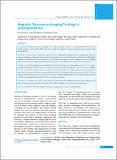Please use this identifier to cite or link to this item:
https://hdl.handle.net/20.500.14356/1634| Title: | Magnetic Resonance Imaging Findings in Spondylodiscitis |
| Authors: | Panta, Om Biju Pathak, Yagya Raj Karki, Dan Bahadur |
| Citation: | PantaO. B., PathakY. R., & KarkiD. B. (2018). Magnetic Resonance Imaging Findings in Spondylodiscitis. Journal of Nepal Health Research Council, 15(3), 217-221. https://doi.org/10.33314/jnhrc.v15i3.1165 |
| Issue Date: | 2017 |
| Publisher: | Nepal Health Research Council |
| Article Type: | Original Article |
| Keywords: | Epidural collection Magnetic resonance imaging Modic changes Spondylodiscitis |
| Series/Report no.: | Sep-Dec, 2017;1165 |
| Abstract: | Abstract Background: Magnetic Resonance Imaging is the imaging modality of choice for imaging spinal infection due to its high sensitivity and specificity. This study aims to study the magnetic resonance imaging changes in patients with spondylodiscitis. Methods: The study was a retrospective study carried in a multimodality imaging centre in Kathmandu. Magnetic resonance imaging records and clinical record of 3 years duration were reviewed and patients with clinical and radiological diagnosis of spondylodiscitis were included in the study. Three radiologists interpreted Magnetic Resonance Imaging with mutual consensus in disputed issues. Data analysis was done with Statistical Package for Social Sciences21.0. Results: A total of 52 patients were included in the study. The mean age of the patients was 43.9 ± 17.6 years. Spondylodiscitis involved lumbar spine in 26(50%) case, cervical and thoracic spine in 13(25%) cases each. Multiple IV discs were involved in 24(46.2%) cases, which was most common in cervical spine and least common in thoracic spine. Only one vertebral end plate was involved in 16(30.8%) cases. Epidural collection was seen in 23(44.2%) cases and paravertebral collection was noted in 63(33.5%) cases. Statistical significant difference in region of spine involved (p=0.02) and epidural collection (p=0.04) was noted between genders. Conclusions: Lumbar spine was the most common level involved with spondylodiscitis, perivertebral enhancing soft tissue was present in all cases, and involvement of disc and the endplates were the most common pattern. Keywords: Epidural collection; magnetic resonance imaging; modic changes; spondylodiscitis. |
| Description: | Original Article |
| URI: | http://103.69.126.140:8080/handle/20.500.14356/1634 |
| ISSN: | Print ISSN: 1727-5482; Online ISSN: 1999-6217 |
| Appears in Collections: | Vol. 15 No. 3 Issue 37 Sep-Dec 2017 |
Files in This Item:
| File | Description | Size | Format | |
|---|---|---|---|---|
| 1165-Manuscript-3045-1-10-20180101.pdf | Fulltext Download | 204.62 kB | Adobe PDF |  View/Open |
Items in DSpace are protected by copyright, with all rights reserved, unless otherwise indicated.
